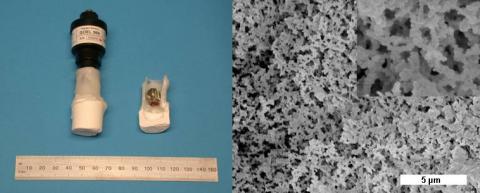Plastron respiration:
Extracting oxygen from water

What can be simpler than a block of white foam? When the foam has a hydrophobic surface it becomes superhydrophobic and when it is immersed in water it retains a silvery looking layer of air around its surface. This provides a water-air interface across which oxygen can diffuse from the water into the internal cavity of the foam. In nature this idea is used by some aquatic insects and spiders to breathe underwater without the need for a gill (plastron respiration). The image on the left shows a superhydrophobic foam with mounted oxygen sensor used to create and investigate a model plastron. By using a zinc-oxide cell inside the foam block to burn up the oxygen, it is possible to show that oxygen is extracted from the water. On the right is a scanning electron microscope image of the pore structure of a methyltriethoxysilane foam; the inset shows a magnified view (x 3).
Read more about this experiment in the publication listed below, and see what James Kay (click here) and the Nottingham Evening Post (click here) thought about the Nottingham experiments.
|
|
This div will be replaced
|
This is an extract from BBC Radio 4's Material World on 9th February 2006. For the full interview click here.
Publication
![]()
Plastron properties of a super-hydrophobic surface,
Appl. Phys. Lett. 89 (10) (2006) Art 104106.
View postprint pdf
![]()
Immersed superhydrophobic surfaces: Gas exchange, slip and drag reduction properties,
Soft Matter 6 (4) (2010) 714-719. View postprint pdf

